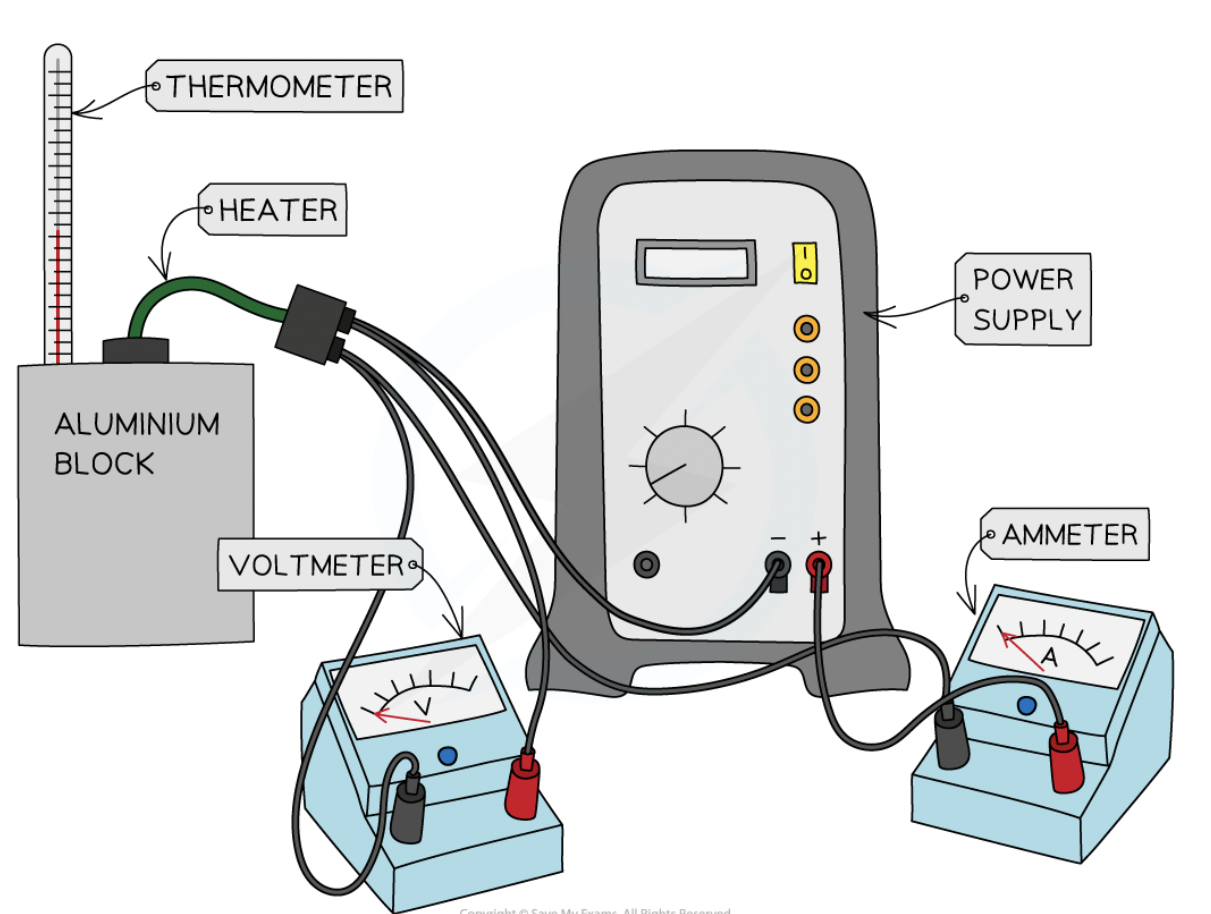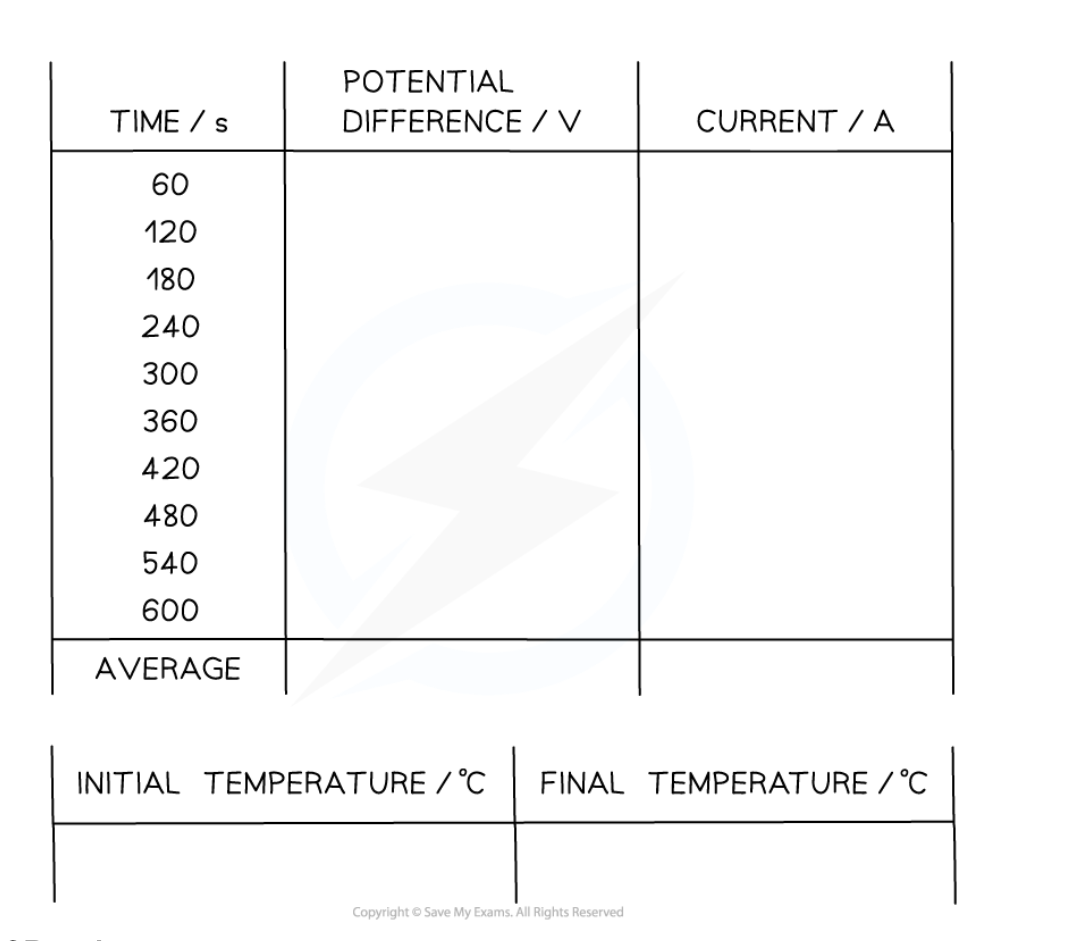Required Practical: Investigating Specific Heat Capacity
1/34
There's no tags or description
Looks like no tags are added yet.
Name | Mastery | Learn | Test | Matching | Spaced |
|---|
No study sessions yet.
35 Terms
what is the aim of the experiment?
The aim of the experiment is to determine the specific heat capacity of a substance, by linking the amount of energy transferred to the substance with the rise in temperature of the substance
what is the independent variable?
Time, t
what is the dependent variable?
Dependent variable = Temperature, θ
what are the 3 control variables?
Material of the block
Current supplied, I
Potential difference supplied, V
how many pieces of equipment is needed?
7
list all the pieces of equipment required
1kg block of metal or a beaker containing a known mass of water
thermometer
immersion heater
power supply
stopwatch
voltmeter
ammeter
purpose of the metal/water?
is the substance to calculate the SHC
purpose of the thermometer?
to measure the temperature rise of the substance
purpose of the immersion heater?
to heat the substance
purpose of the power supply?
to supply power to the heater
purpose of the stopwatch?
to measure the time taken for the substance to heat up by a certain temperature
purpose of the voltmeter?
to determine the p.d through the heater
purpose of the ammeter?
to determine the current from the power supply to the heater
what are the 4 pieces of measuring equipment?
Thermometer
Stopwatch
Voltmeter
Ammeter
what are the different resolutions of the 4 pieces of measuring equipment
Thermometer = 1 °C
Stopwatch = 0.01 s
Voltmeter = 0.1 V
Ammeter = 0.01 A
how many steps are there to the method?
6
1st step to the method
Start by assembling the apparatus, placing the heater into the top of the block
2nd step to the method
Measure the initial temperature of the aluminium block from the thermometer
3rd step to the method
Turn on the power supply and start the stopwatch
4th step to the method (3)
Whilst the power supply is on, the heater will heat up the block.
Take several periodic measurements, eg. every 1 minute of the voltage and current from the voltmeter and ammeter respectively,
calculating an average for each at the end of the experiment up to 10 minutes
5th step to the method
Switch off the power supply, stop the stopwatch and leave the apparatus for about a minute. The temperature will still rise before it cools
6th step to the method
Monitor the thermometer and record the final temperature reached for the block

list the full method of the experiment
Start by assembling the apparatus, placing the heater into the top of the block
Measure the initial temperature of the aluminium block from the thermometer
Turn on the power supply and start the stopwatch
Whilst the power supply is on, the heater will heat up the block. Take several periodic measurements, eg. every 1 minute of the voltage and current from the voltmeter and ammeter respectively, calculating an average for each at the end of the experiment up to 10 minutes
Switch off the power supply, stop the stopwatch and leave the apparatus for about a minute. The temperature will still rise before it cools
Monitor the thermometer and record the final temperature reached for the block
what variables would be used in the results table
time/s → p.d/v → current/A → average → initial temperature → final temperature

What 2 equations would you use to analyse the results and how?
thermal energy supplied to the block should be calculated using:
energy = charge x voltage (E = QV)
charge = current x time (Q = It)
what do the symbols mean in these two equations → energy = charge x voltage (E = QV)
charge = current x time (Q = It)
E = thermal energy, in joules (J)
Q = Charge, in coulombs (C)
I = current, in amperes (A)
V = potential difference, in volts (V)
t = time, in seconds (s)
What steps would you take to combine these two equations: energy = charge x voltage (E = QV)
charge = current x time (Q = It)
Rearrange to make Q the subject - E = QV → Q = E/V
Substitute into the Q = It equation - Q = It → E/V = It
Rearrange to make E the subject - E = IV
what is the equation to calculate the change in thermal energy?
change in thermal energy = mass x SHC x change in temperature
what would be the equation to work out SHC

how would you calculate the change in temperature
change in temperature = final temp = initial temp
how would you calculate the change in energy?
change in energy = (average current x final temperature) - (average current x initial temperature)

What would be a systematic error of this experiment and how would it be avoided?
Make sure the voltmeter and ammeter are initially set to zero, to avoid zero error
What would be a random error of the experiment?
Not all the energy transferred from the heater will be transferred to the block, some will be dissipated to the surroundings into the surroundings and some will be transferred to the thermometer (also part of the surroundings)
This means the measured value of the specific heat capacity is likely to be higher than what it actually is
Give three ways to avoid the random error
make sure the block is fully insulated
A joulemeter could be used to calculate energy directly
This would eliminate errors from the voltmeter, ammeter and the stopwatch
Make sure the temperature value is read at eye level from the thermometer, to avoid parallax error
The experiment can also be repeated with a beaker of water of equal mass, the water should heat up slower than the aluminium block
List 3 safety considerations for this practical
Any 3 out of:
Make sure never to touch the heater whilst it is on, otherwise, it could burn skin or set something on fire
Run any burns immediately under cold running water for at least 5 minutes
Allow time for all the equipment, including the heater, wire and block to cool before packing away the equipment
Keep water away from all electrical equipment
Wear eye protection if using a beaker of hot water